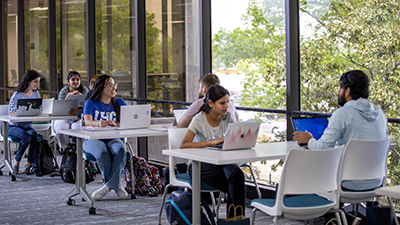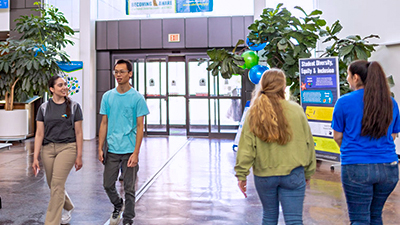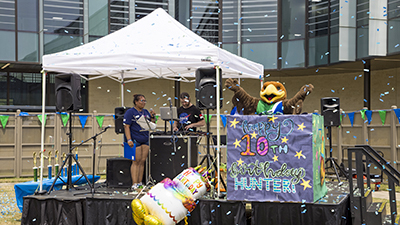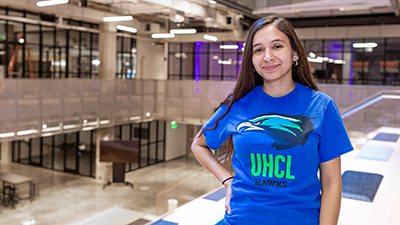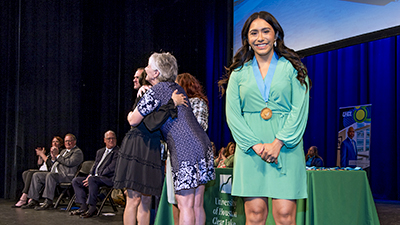Two UHCL profs collaborate to provide ‘opportunities of a lifetime’

Since opening in 2017, University of Houston Clear- Lake’s Human Health and Performance Institute has used science and engineering to guide research, testing, nutrition and exercise, to overcome barriers that limit human performance and become champions on the field of their health. Not only has the HHPI been successful in its numbers, but also by building relationships in the community, and preparing students for their future careers. Its ongoing partnership with KBR demonstrates its efforts to collaborate and help others define best science practices worldwide, while also providing opportunities for students.
Associate Professor of Exercise and Health Science William Amonette, who is also the executive director of the HHPI, said he and Assistant Professor of Mechanical Engineering Ariful Bhuiyan, have found common research interests in biomechanics. They are using exposure to science and engineering through the HHPI, as a mechanism to better prepare students for the multidisciplinary nature of work in the 21st century.
“One such project uses data collected on women professional soccer players in the HHPI, to run robotic simulations to quantify stress in knee ligaments," Amonette said. “We are working towards using real kinematic data collected in professional athletes, coupled with 3D printing of the major bones in the leg, to determine how the geometry of the bones affects knee stress and potential injuries.”
Bhuiyan said that he teaches engineering, but in this case, his biomechanics experience allows him to explain various mechanical concepts to his students in a more engaging manner.
“In our lab, we take data and ask students to analyze it using engineering techniques. Students learn a lot of engineering calculation and aspects of physics from my course. They use it to solve real world problems," he said.
Bhuiyan explained that the mechanical engineering program alone doesn’t give students the human performance knowledge that is missing, so working with the HHPI team helps them understand that piece. The combination of engineering and human performance is what many in the industry are searching for in employees.
Amonette and Bhuiyan’s collaboration provided UHCL alumna Sascha Henderson the opportunity of a lifetime, because NASA was looking to hire someone with a mechanical engineering background that was also familiar with human performance technology.
“She was the ideal candidate,” Amonette said. “The spaceflight industry recognizes the importance of using multidisciplinary approaches to solve the problem of humans living in space. My relationship with Dr. Bhuiyan provided a unique opportunity for a student to couple her engineering skills with human performance science to land a job in the space flight industry, and even better, working for UHCL."
Amonette added that Henderson was also a research assistant at the HHPI, and demonstrated a unique ability to independently problem solve and critically think from the start.
Henderson graduated this past spring and obtained a Bachelor of Science in Mechanical Engineering. Not only is she working For NASA in a KBR lab, but she is employed by UHCL. She is an OCHMO/HMTA Integrator, which serves as a liaison with other NASA organizations, federal agencies, and international partners, to ensure the assigned areas and special projects adequately meet the needs of OCHMO and NASA. Their purpose is to ensure safe and successful execution of human spaceflight exploration.
She said that she always wanted to be a personal trainer growing up, but mechanical engineering was her calling. Having both interests has made her very successful in her role.
“I really enjoy what I do, and the people I work with,” she said. “I’ve been learning a lot, and the team I work with is open to my ideas. They listen to me, give me feedback and make me feel like I belong.”
Henderson added that she was originally afraid to try research, but Bhuiyan saw something in her that she didn’t see in herself.
“I didn’t think I was smart enough, but ‘just doing it’ got me to this point,” she said. I never imagined having a job like this before. I think expanding my horizon and getting to know people was very helpful. UHCL turned out to be such a great experience, and I love the community.”
Amonette said it’s the relationships that have been cultivated over many years that have led to opportunities like this, and he is happy UHCL students are receiving them.
“I believe that our uniqueness as a university, specifically our academic programs, all tie to application. Our instructors see through the lens of not just teaching somebody about something, but teaching them how to do something,” he said. “The reality is, when you go into the workforce, they aren’t really interested in what you know. It’s ‘what can you do?’.”
He added while they are teaching students fundamental concepts, they also teach the application of those concepts through testing, training and technology development. The experiential learning opportunities that students have at UHCL better prepare them for their future careers.
Amonette and Bhuiyan said their goal is to expand and continue to develop the relationships in the community, and to grow UHCL's presence on human health and performance at NASA.
Two other UHCL alumni, Vanessa Jones and Dana Gardner, are also now UHCL employees working with the HHPI and KBR. Jones is a human factors engineer and Gardner is a human performance scientist.
“We want to continue growing our presence on the Johnson Space Center Campus, and also grow UHCL's reputation for producing industry-ready graduates," Amonette said. “As a university and institute, we are grateful to work with KBR as a teammate on their unique mission to preserve astronauts' health while in space. Personally, I am just happy that the university and our great students get to contribute a piece of that mission.”
For more information about UHCL’s HHPI, visit www.uhcl.edu/hhpi/.

